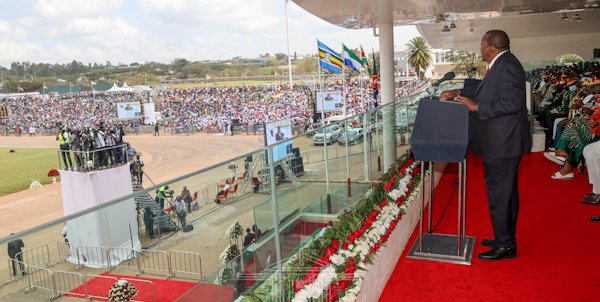Kenya’s President Uhuru Kenyatta defended his administration’s borrowing appetite which has risen to KSh9 trillion as of December 2021, emphasizing that it has been a “catalyst for rapid development”.
The debt comprises KSh4 trillion in domestic debt and KSh4.2 trillion in external debt.
“On this, I want to pose a national question. How much is too much borrowing? When does borrowing become too much and unbearable to a nation?” posed the Head of State during the 59th Madaraka Day Celebrations held at Uhuru Gardens in Nairobi Wednesday.
“The only time that debt is a burden to a nation is if the nation is led by a cabal of looters. But in the hands of a visionary administration, debt is a catalyst for rapid development,” he said.
According to President Kenyatta, in order for Kenya to keep up the pace of increased and accelerated achievement, the next administration should not be afraid to borrow.
“The next administration should not shy away from using other people’s money. Debt, in a cleaned-up government, is an enabler, not a burden.”
“On my part, I believe we have used other people’s money to close our infrastructure gap to connect our markets… If we can transport 10 times more passengers with Standard Gauge Railway at half the price and half the time and move three times more cargo daily from Mombasa to our neighbours, then our borrowing has surely been worthwhile and paid tangible dividends.”
The Head of State noted that the investments made have facilitated trade catapulting Kenya to become Africa’s 6th largest economy from the 12th when he assumed office.
“At the same time, we have tripled the wealth of our nation, from a Gross Domestic Product (GDP) of Ksh 4.5 trillion to close to Ksh 13 trillion today. As a mark of this remarkable growth, our tax revenues have doubled from Ksh 800 billion in 2012 to Ksh 1.6 trillion as at April 2022.”
Government revenue directed towards debt repayment
Subsequently, the National Treasury has proposed a debt ceiling at Ksh.10 trillion from Ksh 9 trillion to enable it to finance the deficit in the 2022-2023 fiscal year.
Through a Gazette notice issued on May 26, Treasury CS Ukur Yattani has urged the Members of Parliament (MP) to amend the Public Finance Management(national government) Regulations, 2015, to increase the limit.
The National Treasury in its Medium Term Debt Management Strategy 2022 estimates total public debt service as a proportion of Government revenue at 50 percent and 52.4 percent in FY2020/21 and FY2021/22 respectively with forecasts showing a further increase in FY2022/23 and FY2023/24.
“This means that a huge proportion of Government revenue is directed towards debt repayment obligations rather than financing development expenditure. This scenario also increases the pressure on tax authorities to exceed revenue targets,” Analysts from Sterling Capital Research state in their fixed income report for the month of June 2022 titled “Bridging the funding gap with an IFB”.
“A growing fiscal deficit however means that this ratio will continue to deteriorate, a trend that will be worsened by rising interest rates locally and globally together with a depreciating local currency.”
In spite of the gloomy outlook, the Central Bank of Kenya says leading economic indicators have shown continued strong performance in the first quarter of 2022.
“Economic growth is expected to remain strong in 2022 despite the downside risks to global growth,” Njoroge said during the post-Monetary Policy Committee (MPC) media briefing Tuesday.
The MPC also observed that leading economic indicators show strong continued performance in the first quarter of 2022, supported by robust activity in construction, information and communication, wholesale and retail trade, transport as well as manufacturing sectors.
In addition, it observed that exports have remained strong, growing by 11.1 percent in the 12 months to April 2022 compared to a similar period in 2021.
However, the pace of imports surpassed those of exports, growing 29 percent in the 12 months to April 2022 compared to a decline of 5.7 percent in the 12 months to April 2021, mainly reflecting increased imports of oil and intermediate goods.
Khusoko is now on Telegram. Click here to join our channel and stay updated with the latest African business news and updates.





